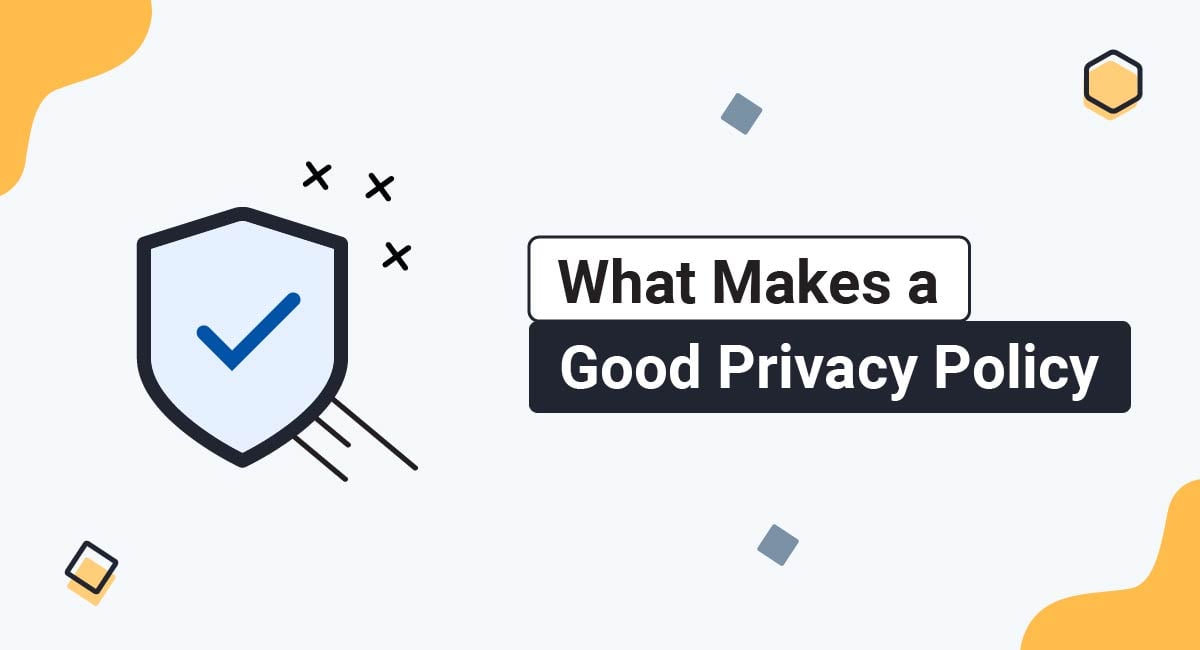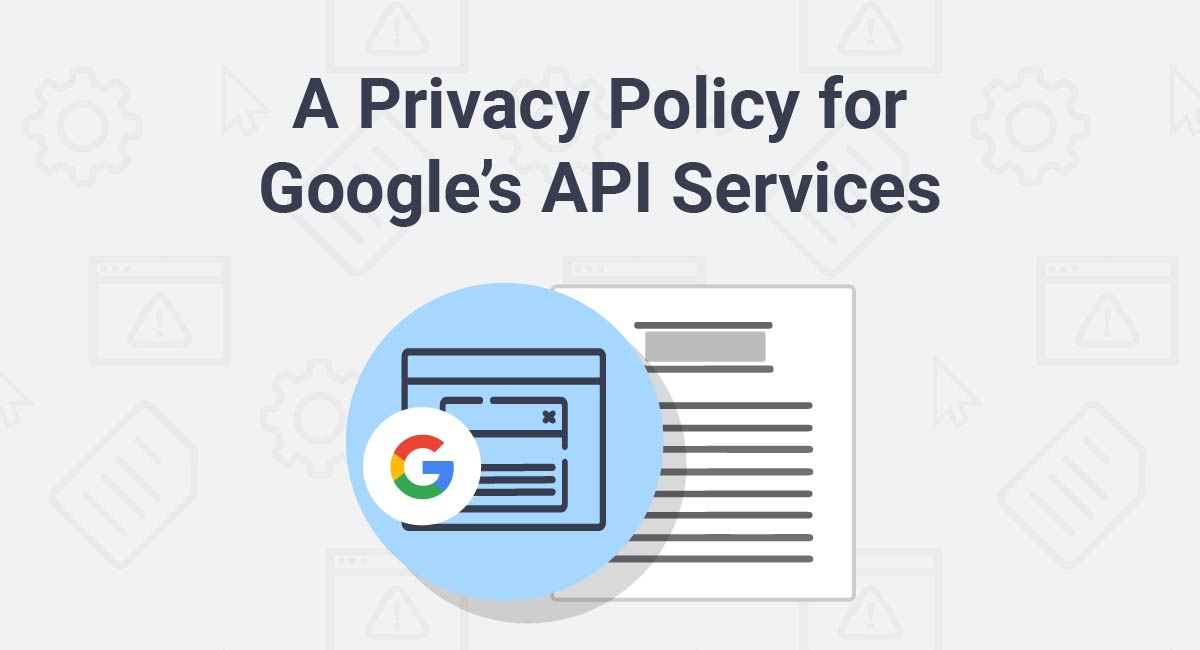Businesses, websites and mobile apps collect large amounts of information from users, from email addresses and names to shipping addresses and financial data. And it's important that your users understand what you use their personal information for.
Including a clause about how you use personal information (personal data) you collect within your Privacy Policy helps with this understanding. It also helps you comply with privacy laws.
This article explains what this clause is, why you need one, and how to create one for your Privacy Policy.
Our Privacy Policy Generator makes it easy to create a Privacy Policy for your business. Just follow these steps:
-
At Step 1, select the Website option or App option or both.

-
Answer some questions about your website or app.

-
Answer some questions about your business.

-
Enter the email address where you'd like the Privacy Policy delivered and click "Generate."

You'll be able to instantly access and download your new Privacy Policy.
- 1. What is a "How Do We Use Your Information" Clause?
- 2. Why Should I Have a "How Do We Use Your Information" Clause in My Privacy Policy?
- 3. Is a "How We Use Your Information" Clause Required By Law?
- 4. How Do I Write a "How Do We Use Your Information" Clause?
- 4.1. If You Process Orders and Complete Transactions
- 4.2. If You Engage in Marketing and Advertising
- 4.3. If You Do Service Improvements and Boost Functionality
- 5. How Do I Format a "How Do We Use Your Information" Clause?
- 5.1. Use Clear Language and Formatting
- 5.1.1. Using Short Paragraphs
- 5.1.2. Using Bullet Points
- 6. How Do I Display a Privacy Policy With a "How We Use Your Information" Clause?
- 6.1. In Website Footers
- 6.2. In Newsletter Subscription Forms
- 6.3. In Contact Forms
- 6.4. In Account Sign-Up Forms
- 6.5. In Mobile Apps
- 7. Summary
What is a "How Do We Use Your Information" Clause?
A "How Do We Use Your Information" clause in a Privacy Policy discloses the specific ways a business uses the personal information it collects from or about users.
The goal of it is to be as transparent as possible so users will know how their information is going to be used before they opt to share it with you.
Here's an example of a standard "How Do We Use Your Information" clause:
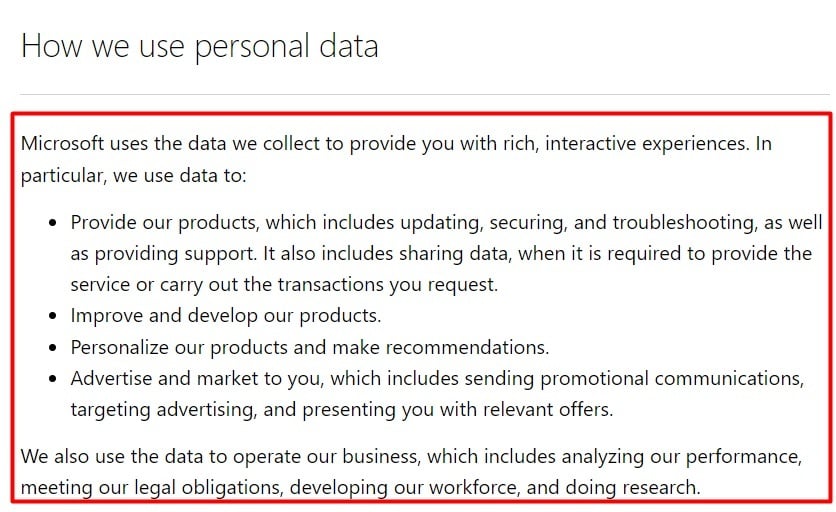
Why Should I Have a "How Do We Use Your Information" Clause in My Privacy Policy?
There are two main reasons to include a "How Do We Use Your Information" clause in your Privacy Policy.
First, including it can reassure your website's visitors by clarifying how your business uses their personal information. It provides transparency and answers a question users will surely have when considering sharing their personal information with you. In short, it helps build trust and credibility with your users.
Secondly, global privacy laws like Europe's GDPR and California's CCPA/CPRA require that you disclose this information. Without doing so, you will be violating laws.
Is a "How We Use Your Information" Clause Required By Law?
Yes, a "How Do We Use Your Information" clause is required by law.
Disclosing how personal information is going to be used is a key aspect of the spirit behind global privacy laws. Because of this, privacy laws around the world require that you disclose this information, and a "How Do We Use Your Information" clause is a best practice way of doing so.
Just some of the laws that require the disclosure of how personal information will or may be used include the following:
- EU's GDPR
- California/USA's CCPA/CPRA
- Maryland/USA's PIPA
- Canada's PIPEDA
- New Zealand's Privacy Act 2020
How Do I Write a "How Do We Use Your Information" Clause?
Your "How Do We Use Your Information" clause will be unique and specific to your business practices, since you and only you know how you use the information you collect.
The most important thing to do here is to disclose all the ways in which you use personal information, even if it's just occasionally or rarely.
Your "How Do We Use Your Information" clause must accurately disclose all the ways you actually use the personal information you collect.
Sit down with members of your team and do an audit to fully and accurately discover all the ways your business is using personal information. Knowing this is crucial to writing your clause.
Some examples of ways personal information is commonly used include the following:
- To improve your website or mobile app functioning
- To send marketing communications
- To mail out products
- To complete contracts
- To comply with laws
- For research purposes
The following instances are very common across businesses and industries.
If You Process Orders and Complete Transactions
If you use personal information to process orders or complete transactions, let users know what type of information you will use for such activities, and how.
Common data types used for processing orders and completing transactions include the following:
- Names, to verify financial information and identity
- Physical/mailing addresses to ship products directly to
- Financial information to process payment for orders and service costs
- Email addresses to send shipping and other confirmations to
Amazon provides a long list of how and why it uses personal information. It includes a section noting that it uses it to take and handle orders, to deliver products and services, process payments, and to communicate with the shopper about this and more:
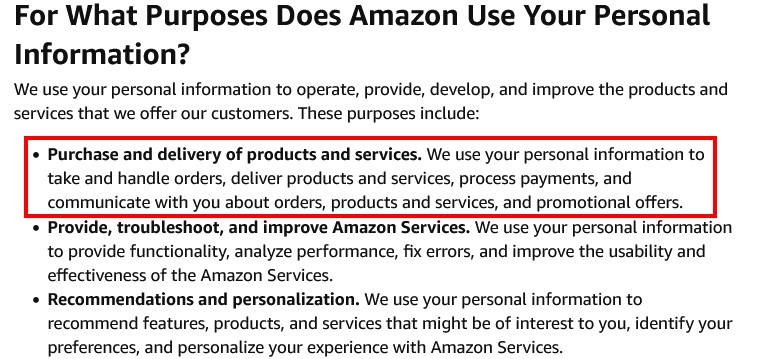
Here's how United Cargo notes that it uses information for facilitating transactions:
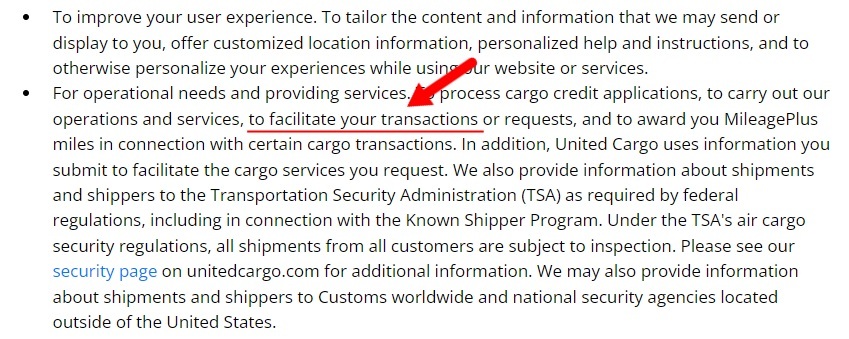
If You Engage in Marketing and Advertising
Clearly state if you use personal information to engage in marketing campaigns, personalized advertisements and other sorts of promotions or offers.
Here's how KIA notes that it uses personal information to provide personalized and improved advertisements and content, as well as to facilitate things like promotions:

Here's how Amazon discloses that it uses personal information for personalized product recommendations:
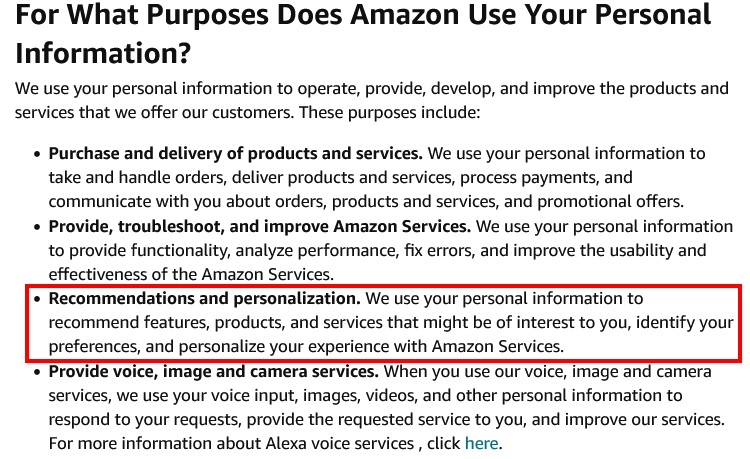
If You Do Service Improvements and Boost Functionality
Users may figure that you'll use their personal information to communicate with them, but they may not realize that you will use it as part of overall website or app improvements to features and functionality.
This makes it even more important to disclose this since it isn't such an intuitive use of personal information.
Again, from Amazon, it is disclosed to users that personal information will be used for things such as

Remember, your clause will be unique to your actual business practices, and your actual business practices are what you need to disclose.
How Do I Format a "How Do We Use Your Information" Clause?
Your "How Do We Use Your Information" clause should be written in a way that's easy for users to read and understand, and that is as accurate as possible.
Here are some tips and guidance for writing this clause for your Privacy Policy.
Use Clear Language and Formatting
When writing your clause, always avoid legalese and complex industry terms. Use clear language that mostly anyone would be able to understand.
Using formatting tools such as short paragraphs and bullet points will help guide the reader and make your clause more organized and readable.
Using Short Paragraphs
When you're writing this clause, you should make sure your paragraphs are short and to the point. This will help with readability and transparency.
Here's an example of a clause that uses a number of short paragraphs to explain to users how their personal information is used. You can see how the spacing between paragraphs also helps with readability:
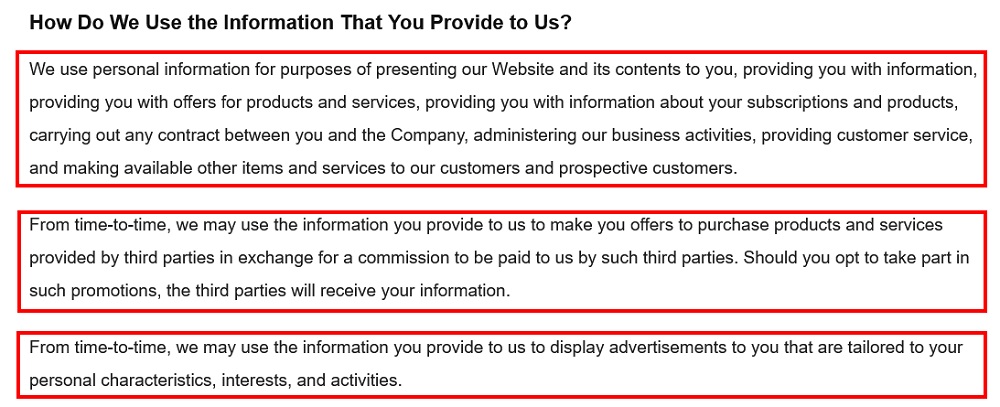
Using Bullet Points
Bullet points streamline complex information into easy-to-read lists. With a clause like this one, a list is perfect, as the ways you use personal information should be something easy to list out.
Here's an example:

Mauka Digital also uses bullet points to disclose information in a neat, organized manner that's easy to read:

You can even use numbers or letters, as seen here, to organize your lists:
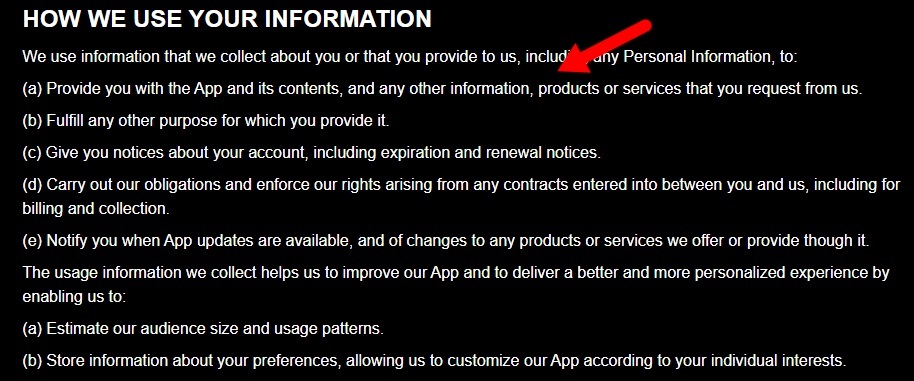
This example from Shopify combines both short paragraphs with bullet lists to disclose levels of how it uses information:

After you draft your clause, it's time to display it.
How Do I Display a Privacy Policy With a "How We Use Your Information" Clause?
Your "How We Use Your Information" clause will be displayed within your Privacy Policy. And, your Privacy Policy should be linked in a variety of places on your website and mobile app to ensure users see it and can access it at any time.
Some common areas to display a Privacy Policy include in your website's footer, in an in-app menu, in an account creation form, and in newsletter sign-up forms.
By including a link to your Privacy Policy in a variety of prominent, easy-to-see locations, you're guaranteeing that whether users are just browsing your site, joining, or checking in, they're only a click away from understanding how you use their information.
In Website Footers
Your website footer should include a link to your Privacy Policy that includes your "How Do We Use Your Information" clause. This is a typical spot where customers look for important links on websites.
Here's an example from Outdoor Fellow:

In Newsletter Subscription Forms
When you're collecting email addresses, which count as protected personal information, it's a great time to share your Privacy Policy so users have a chance to see how you'll be using their email address and other personal information if they share it by signing up.
Here's an example from The Conversation:
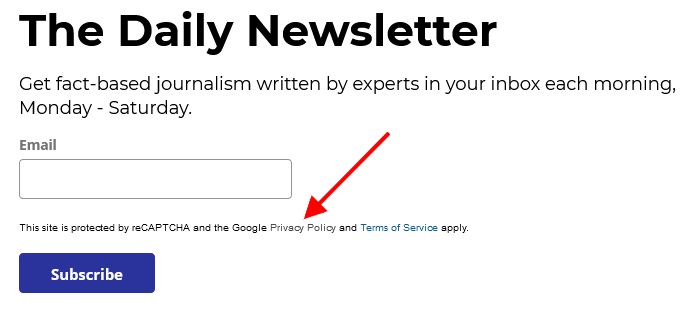
In Contact Forms
Link your Privacy Policy in contact forms since you'll be collecting personal information such as an email address and a name.
Here's an example of how you can do this:
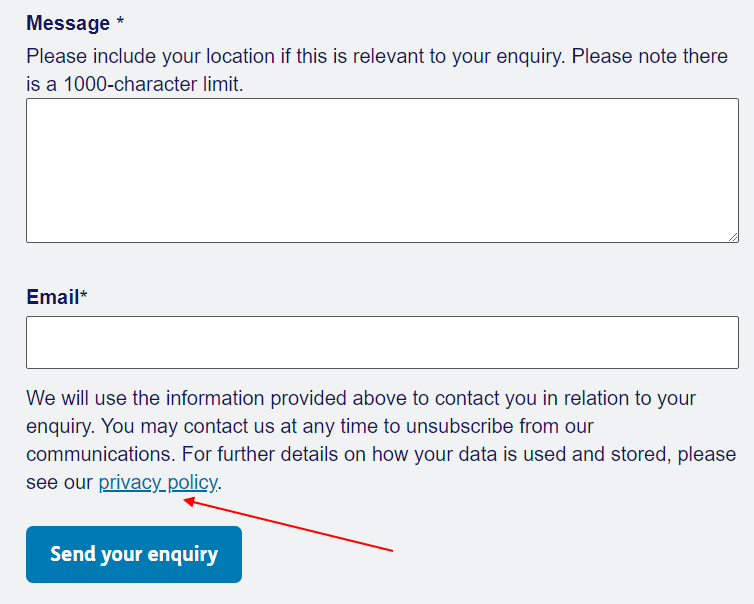
In Account Sign-Up Forms
When users sign up for an account with you, present your Privacy Policy. You'll be collecting a variety of personal information in this process, especially if you have an ecommerce component and users can make purchases.
Here's an example:
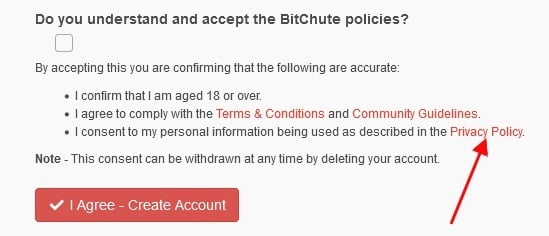
In Mobile Apps
Add a link to your Privacy Policy within your mobile app, in an in-app menu such as a Legal or Settings menu.
Here's an example of this:
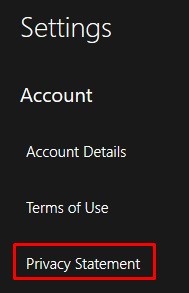
Summary
A "How Do We Use Your Information" clause is a legal necessity for your Privacy Policy. It's where you disclose how you use information, such as for (but not limited to) the following purposes:
- Improving your website or mobile app
- Sending marketing communications
- Mailing out products and completing orders
- Completing contracts
- Comply with laws
Add a link to your Privacy Policy in places where users will easily find it, such as your website footer, in contact forms and in email newsletter sign up forms. Include it in your mobile app as well, such as in a Legal menu or similar section of the app.

Comprehensive compliance starts with a Privacy Policy.
Comply with the law with our agreements, policies, and consent banners. Everything is included.


